Critical Analysis of Pohutu Wines Ltd Case Study for BMGT7009
VerifiedAdded on 2022/08/18
|12
|4255
|15
Case Study
AI Summary
This assignment presents a critical analysis of the Pohutu Wines Ltd case study, focusing on the application of strategic management tools to support leadership decision-making. The analysis explores the relevance and application of SWOT, PEST, and Porter's Five Forces frameworks to the company's context, supported by academic literature. The assignment also delves into the core values underpinning Pohutu Wines and their impact on both short-term and long-term business objectives. It evaluates how these values influence employee motivation and customer relations. The assignment provides a comprehensive understanding of the strategic management process within Pohutu Wines, including the decision-making approach employed by its leaders.
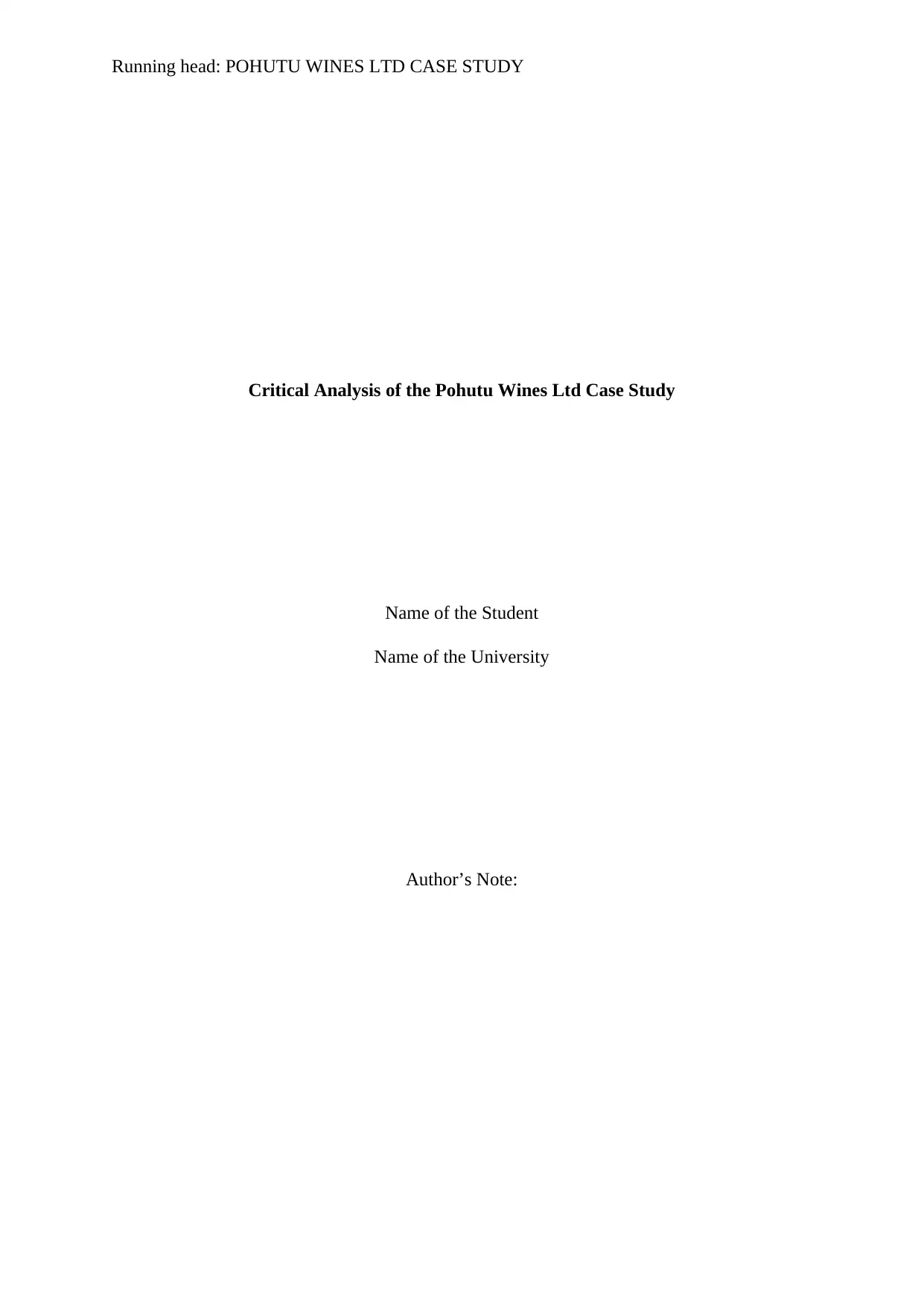
Running head: POHUTU WINES LTD CASE STUDY
Critical Analysis of the Pohutu Wines Ltd Case Study
Name of the Student
Name of the University
Author’s Note:
Critical Analysis of the Pohutu Wines Ltd Case Study
Name of the Student
Name of the University
Author’s Note:
Paraphrase This Document
Need a fresh take? Get an instant paraphrase of this document with our AI Paraphraser
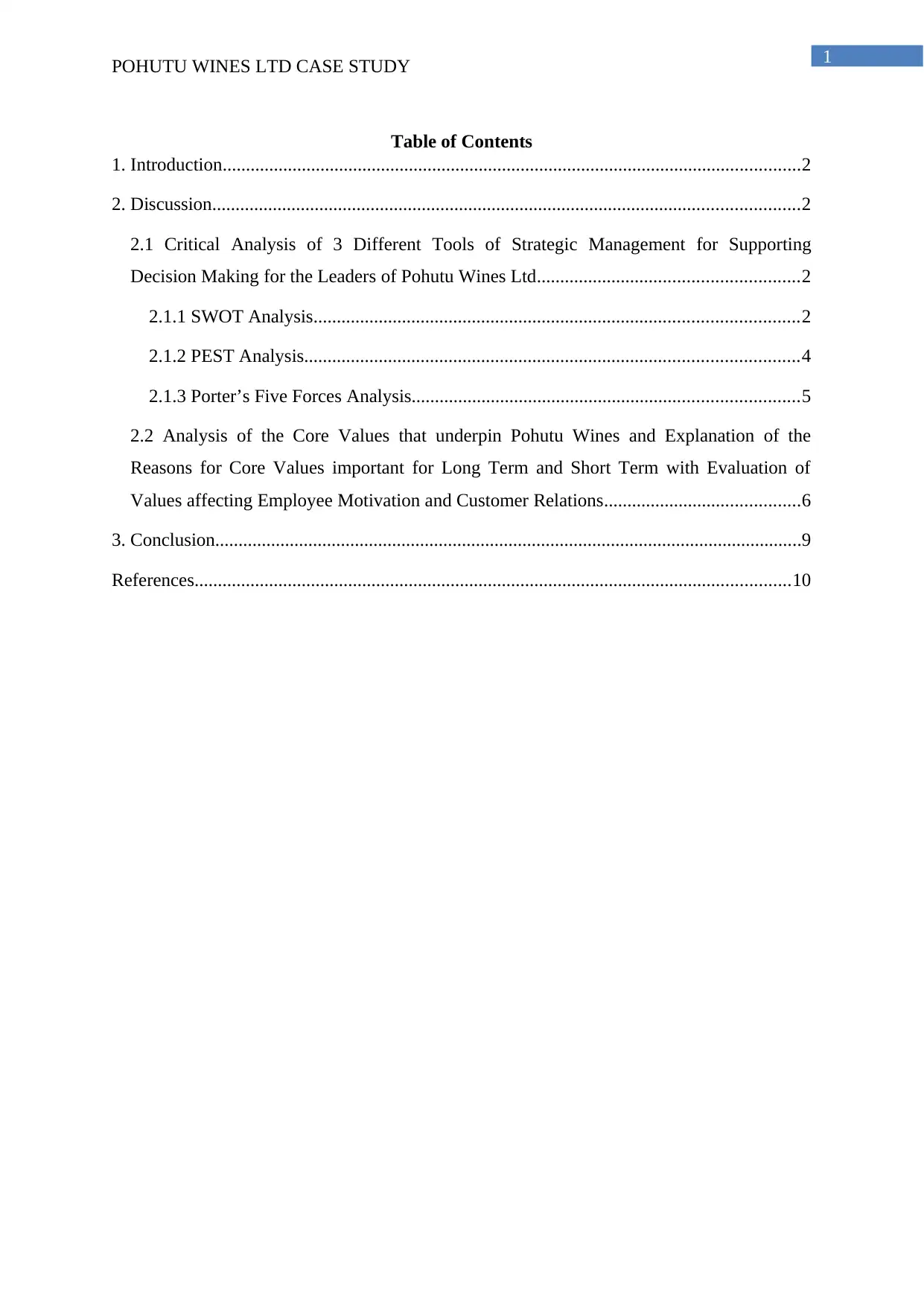
1
POHUTU WINES LTD CASE STUDY
Table of Contents
1. Introduction............................................................................................................................2
2. Discussion..............................................................................................................................2
2.1 Critical Analysis of 3 Different Tools of Strategic Management for Supporting
Decision Making for the Leaders of Pohutu Wines Ltd........................................................2
2.1.1 SWOT Analysis........................................................................................................2
2.1.2 PEST Analysis..........................................................................................................4
2.1.3 Porter’s Five Forces Analysis...................................................................................5
2.2 Analysis of the Core Values that underpin Pohutu Wines and Explanation of the
Reasons for Core Values important for Long Term and Short Term with Evaluation of
Values affecting Employee Motivation and Customer Relations..........................................6
3. Conclusion..............................................................................................................................9
References................................................................................................................................10
POHUTU WINES LTD CASE STUDY
Table of Contents
1. Introduction............................................................................................................................2
2. Discussion..............................................................................................................................2
2.1 Critical Analysis of 3 Different Tools of Strategic Management for Supporting
Decision Making for the Leaders of Pohutu Wines Ltd........................................................2
2.1.1 SWOT Analysis........................................................................................................2
2.1.2 PEST Analysis..........................................................................................................4
2.1.3 Porter’s Five Forces Analysis...................................................................................5
2.2 Analysis of the Core Values that underpin Pohutu Wines and Explanation of the
Reasons for Core Values important for Long Term and Short Term with Evaluation of
Values affecting Employee Motivation and Customer Relations..........................................6
3. Conclusion..............................................................................................................................9
References................................................................................................................................10
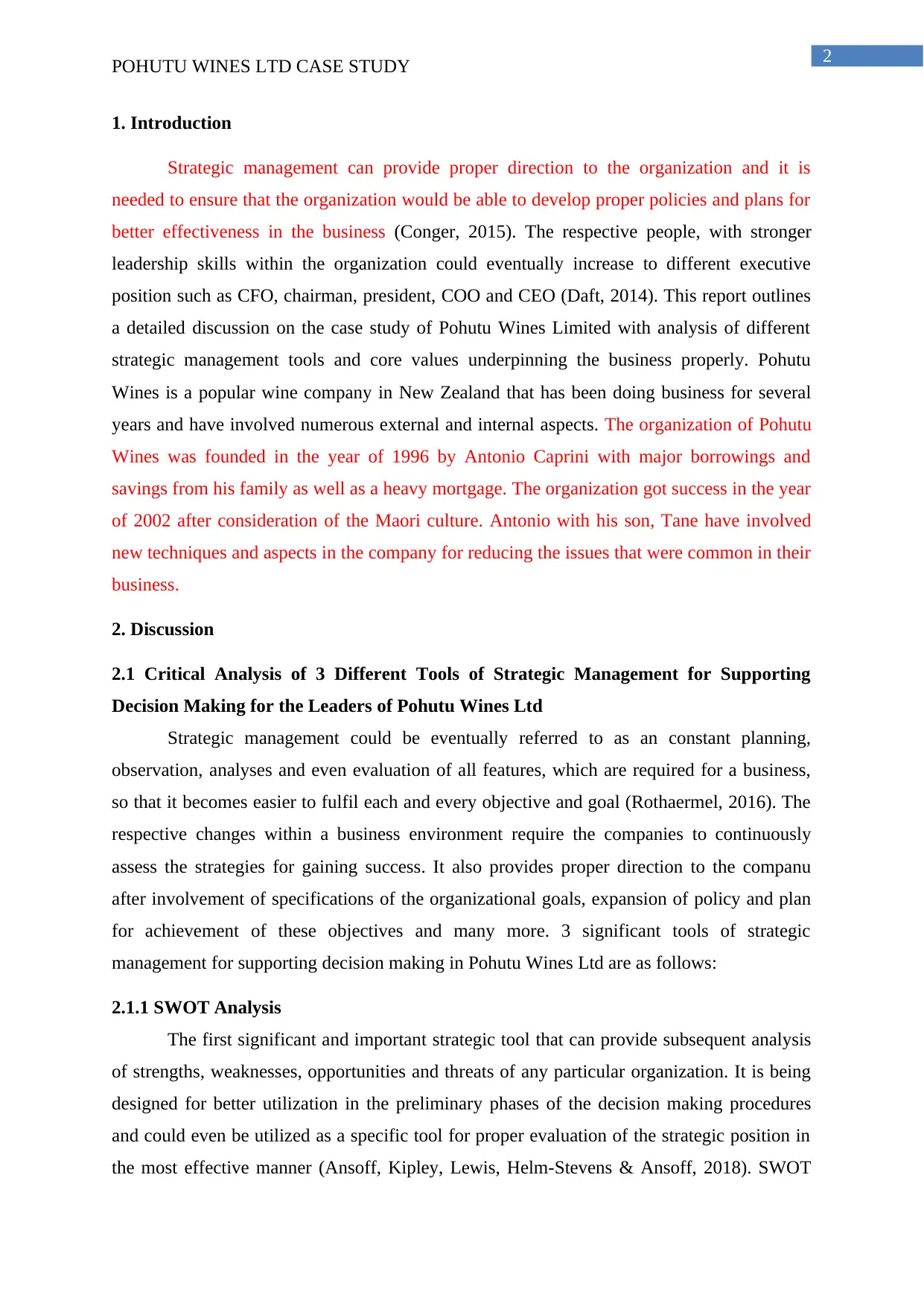
2
POHUTU WINES LTD CASE STUDY
1. Introduction
Strategic management can provide proper direction to the organization and it is
needed to ensure that the organization would be able to develop proper policies and plans for
better effectiveness in the business (Conger, 2015). The respective people, with stronger
leadership skills within the organization could eventually increase to different executive
position such as CFO, chairman, president, COO and CEO (Daft, 2014). This report outlines
a detailed discussion on the case study of Pohutu Wines Limited with analysis of different
strategic management tools and core values underpinning the business properly. Pohutu
Wines is a popular wine company in New Zealand that has been doing business for several
years and have involved numerous external and internal aspects. The organization of Pohutu
Wines was founded in the year of 1996 by Antonio Caprini with major borrowings and
savings from his family as well as a heavy mortgage. The organization got success in the year
of 2002 after consideration of the Maori culture. Antonio with his son, Tane have involved
new techniques and aspects in the company for reducing the issues that were common in their
business.
2. Discussion
2.1 Critical Analysis of 3 Different Tools of Strategic Management for Supporting
Decision Making for the Leaders of Pohutu Wines Ltd
Strategic management could be eventually referred to as an constant planning,
observation, analyses and even evaluation of all features, which are required for a business,
so that it becomes easier to fulfil each and every objective and goal (Rothaermel, 2016). The
respective changes within a business environment require the companies to continuously
assess the strategies for gaining success. It also provides proper direction to the companu
after involvement of specifications of the organizational goals, expansion of policy and plan
for achievement of these objectives and many more. 3 significant tools of strategic
management for supporting decision making in Pohutu Wines Ltd are as follows:
2.1.1 SWOT Analysis
The first significant and important strategic tool that can provide subsequent analysis
of strengths, weaknesses, opportunities and threats of any particular organization. It is being
designed for better utilization in the preliminary phases of the decision making procedures
and could even be utilized as a specific tool for proper evaluation of the strategic position in
the most effective manner (Ansoff, Kipley, Lewis, Helm-Stevens & Ansoff, 2018). SWOT
POHUTU WINES LTD CASE STUDY
1. Introduction
Strategic management can provide proper direction to the organization and it is
needed to ensure that the organization would be able to develop proper policies and plans for
better effectiveness in the business (Conger, 2015). The respective people, with stronger
leadership skills within the organization could eventually increase to different executive
position such as CFO, chairman, president, COO and CEO (Daft, 2014). This report outlines
a detailed discussion on the case study of Pohutu Wines Limited with analysis of different
strategic management tools and core values underpinning the business properly. Pohutu
Wines is a popular wine company in New Zealand that has been doing business for several
years and have involved numerous external and internal aspects. The organization of Pohutu
Wines was founded in the year of 1996 by Antonio Caprini with major borrowings and
savings from his family as well as a heavy mortgage. The organization got success in the year
of 2002 after consideration of the Maori culture. Antonio with his son, Tane have involved
new techniques and aspects in the company for reducing the issues that were common in their
business.
2. Discussion
2.1 Critical Analysis of 3 Different Tools of Strategic Management for Supporting
Decision Making for the Leaders of Pohutu Wines Ltd
Strategic management could be eventually referred to as an constant planning,
observation, analyses and even evaluation of all features, which are required for a business,
so that it becomes easier to fulfil each and every objective and goal (Rothaermel, 2016). The
respective changes within a business environment require the companies to continuously
assess the strategies for gaining success. It also provides proper direction to the companu
after involvement of specifications of the organizational goals, expansion of policy and plan
for achievement of these objectives and many more. 3 significant tools of strategic
management for supporting decision making in Pohutu Wines Ltd are as follows:
2.1.1 SWOT Analysis
The first significant and important strategic tool that can provide subsequent analysis
of strengths, weaknesses, opportunities and threats of any particular organization. It is being
designed for better utilization in the preliminary phases of the decision making procedures
and could even be utilized as a specific tool for proper evaluation of the strategic position in
the most effective manner (Ansoff, Kipley, Lewis, Helm-Stevens & Ansoff, 2018). SWOT
⊘ This is a preview!⊘
Do you want full access?
Subscribe today to unlock all pages.

Trusted by 1+ million students worldwide
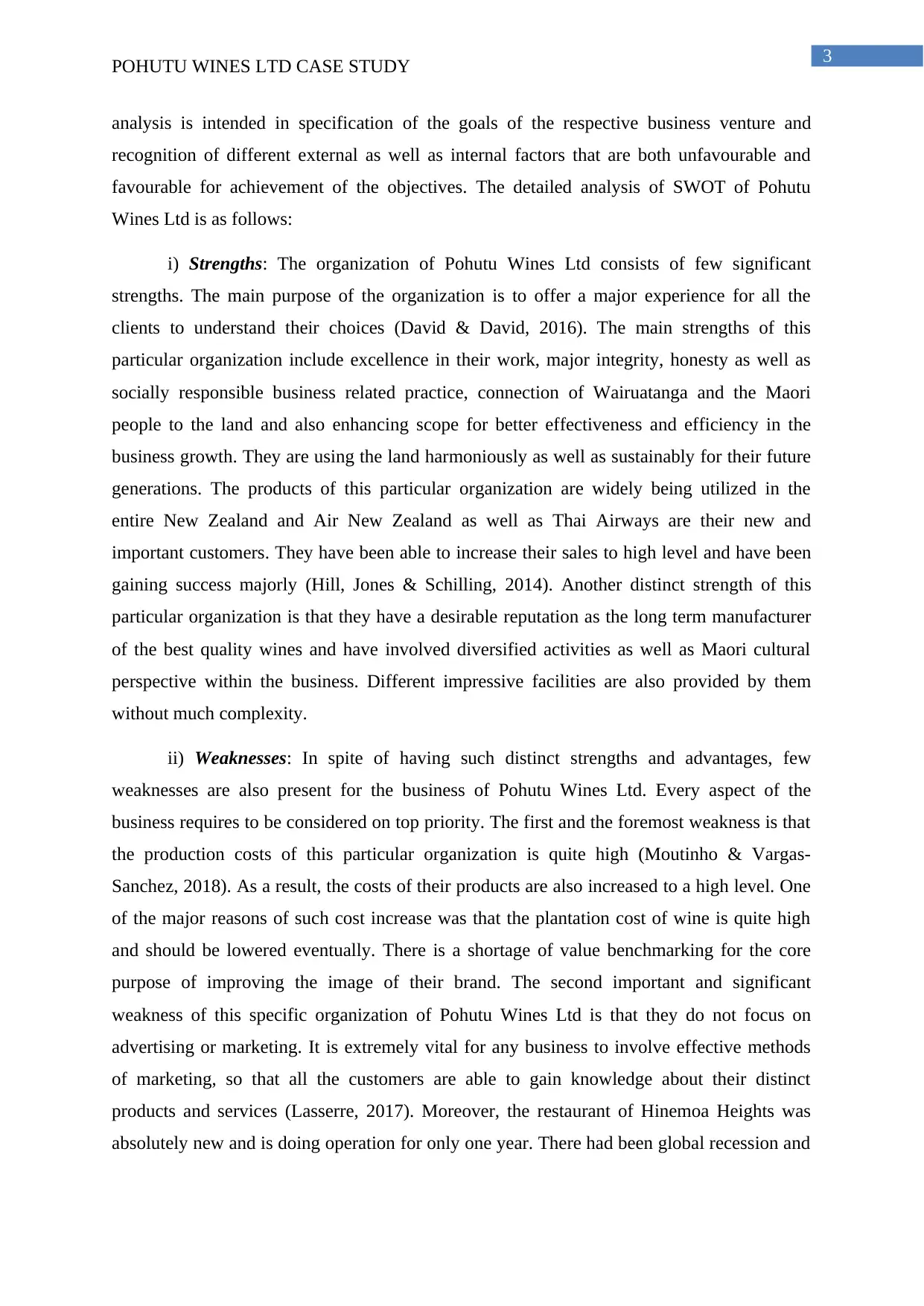
3
POHUTU WINES LTD CASE STUDY
analysis is intended in specification of the goals of the respective business venture and
recognition of different external as well as internal factors that are both unfavourable and
favourable for achievement of the objectives. The detailed analysis of SWOT of Pohutu
Wines Ltd is as follows:
i) Strengths: The organization of Pohutu Wines Ltd consists of few significant
strengths. The main purpose of the organization is to offer a major experience for all the
clients to understand their choices (David & David, 2016). The main strengths of this
particular organization include excellence in their work, major integrity, honesty as well as
socially responsible business related practice, connection of Wairuatanga and the Maori
people to the land and also enhancing scope for better effectiveness and efficiency in the
business growth. They are using the land harmoniously as well as sustainably for their future
generations. The products of this particular organization are widely being utilized in the
entire New Zealand and Air New Zealand as well as Thai Airways are their new and
important customers. They have been able to increase their sales to high level and have been
gaining success majorly (Hill, Jones & Schilling, 2014). Another distinct strength of this
particular organization is that they have a desirable reputation as the long term manufacturer
of the best quality wines and have involved diversified activities as well as Maori cultural
perspective within the business. Different impressive facilities are also provided by them
without much complexity.
ii) Weaknesses: In spite of having such distinct strengths and advantages, few
weaknesses are also present for the business of Pohutu Wines Ltd. Every aspect of the
business requires to be considered on top priority. The first and the foremost weakness is that
the production costs of this particular organization is quite high (Moutinho & Vargas-
Sanchez, 2018). As a result, the costs of their products are also increased to a high level. One
of the major reasons of such cost increase was that the plantation cost of wine is quite high
and should be lowered eventually. There is a shortage of value benchmarking for the core
purpose of improving the image of their brand. The second important and significant
weakness of this specific organization of Pohutu Wines Ltd is that they do not focus on
advertising or marketing. It is extremely vital for any business to involve effective methods
of marketing, so that all the customers are able to gain knowledge about their distinct
products and services (Lasserre, 2017). Moreover, the restaurant of Hinemoa Heights was
absolutely new and is doing operation for only one year. There had been global recession and
POHUTU WINES LTD CASE STUDY
analysis is intended in specification of the goals of the respective business venture and
recognition of different external as well as internal factors that are both unfavourable and
favourable for achievement of the objectives. The detailed analysis of SWOT of Pohutu
Wines Ltd is as follows:
i) Strengths: The organization of Pohutu Wines Ltd consists of few significant
strengths. The main purpose of the organization is to offer a major experience for all the
clients to understand their choices (David & David, 2016). The main strengths of this
particular organization include excellence in their work, major integrity, honesty as well as
socially responsible business related practice, connection of Wairuatanga and the Maori
people to the land and also enhancing scope for better effectiveness and efficiency in the
business growth. They are using the land harmoniously as well as sustainably for their future
generations. The products of this particular organization are widely being utilized in the
entire New Zealand and Air New Zealand as well as Thai Airways are their new and
important customers. They have been able to increase their sales to high level and have been
gaining success majorly (Hill, Jones & Schilling, 2014). Another distinct strength of this
particular organization is that they have a desirable reputation as the long term manufacturer
of the best quality wines and have involved diversified activities as well as Maori cultural
perspective within the business. Different impressive facilities are also provided by them
without much complexity.
ii) Weaknesses: In spite of having such distinct strengths and advantages, few
weaknesses are also present for the business of Pohutu Wines Ltd. Every aspect of the
business requires to be considered on top priority. The first and the foremost weakness is that
the production costs of this particular organization is quite high (Moutinho & Vargas-
Sanchez, 2018). As a result, the costs of their products are also increased to a high level. One
of the major reasons of such cost increase was that the plantation cost of wine is quite high
and should be lowered eventually. There is a shortage of value benchmarking for the core
purpose of improving the image of their brand. The second important and significant
weakness of this specific organization of Pohutu Wines Ltd is that they do not focus on
advertising or marketing. It is extremely vital for any business to involve effective methods
of marketing, so that all the customers are able to gain knowledge about their distinct
products and services (Lasserre, 2017). Moreover, the restaurant of Hinemoa Heights was
absolutely new and is doing operation for only one year. There had been global recession and
Paraphrase This Document
Need a fresh take? Get an instant paraphrase of this document with our AI Paraphraser
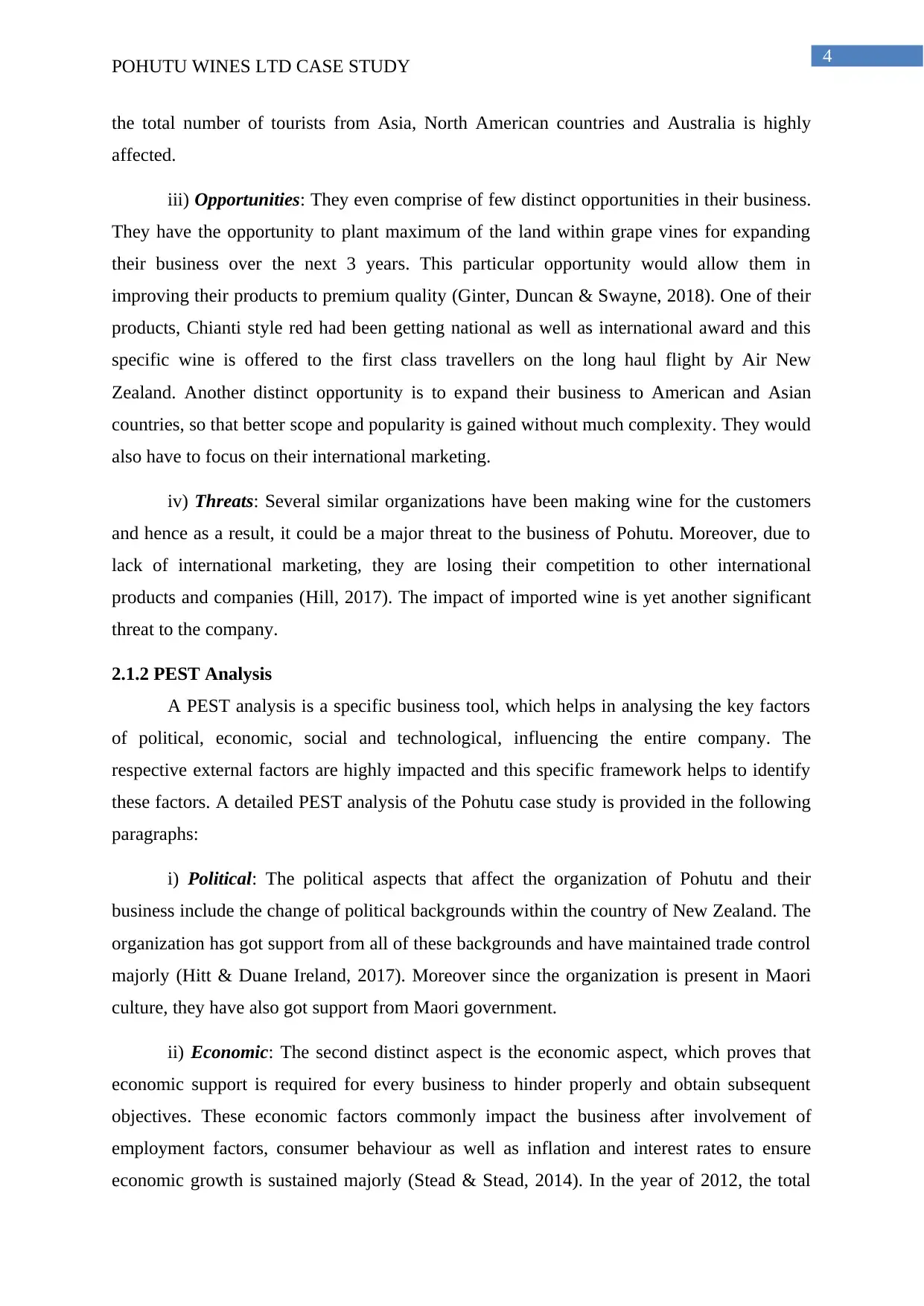
4
POHUTU WINES LTD CASE STUDY
the total number of tourists from Asia, North American countries and Australia is highly
affected.
iii) Opportunities: They even comprise of few distinct opportunities in their business.
They have the opportunity to plant maximum of the land within grape vines for expanding
their business over the next 3 years. This particular opportunity would allow them in
improving their products to premium quality (Ginter, Duncan & Swayne, 2018). One of their
products, Chianti style red had been getting national as well as international award and this
specific wine is offered to the first class travellers on the long haul flight by Air New
Zealand. Another distinct opportunity is to expand their business to American and Asian
countries, so that better scope and popularity is gained without much complexity. They would
also have to focus on their international marketing.
iv) Threats: Several similar organizations have been making wine for the customers
and hence as a result, it could be a major threat to the business of Pohutu. Moreover, due to
lack of international marketing, they are losing their competition to other international
products and companies (Hill, 2017). The impact of imported wine is yet another significant
threat to the company.
2.1.2 PEST Analysis
A PEST analysis is a specific business tool, which helps in analysing the key factors
of political, economic, social and technological, influencing the entire company. The
respective external factors are highly impacted and this specific framework helps to identify
these factors. A detailed PEST analysis of the Pohutu case study is provided in the following
paragraphs:
i) Political: The political aspects that affect the organization of Pohutu and their
business include the change of political backgrounds within the country of New Zealand. The
organization has got support from all of these backgrounds and have maintained trade control
majorly (Hitt & Duane Ireland, 2017). Moreover since the organization is present in Maori
culture, they have also got support from Maori government.
ii) Economic: The second distinct aspect is the economic aspect, which proves that
economic support is required for every business to hinder properly and obtain subsequent
objectives. These economic factors commonly impact the business after involvement of
employment factors, consumer behaviour as well as inflation and interest rates to ensure
economic growth is sustained majorly (Stead & Stead, 2014). In the year of 2012, the total
POHUTU WINES LTD CASE STUDY
the total number of tourists from Asia, North American countries and Australia is highly
affected.
iii) Opportunities: They even comprise of few distinct opportunities in their business.
They have the opportunity to plant maximum of the land within grape vines for expanding
their business over the next 3 years. This particular opportunity would allow them in
improving their products to premium quality (Ginter, Duncan & Swayne, 2018). One of their
products, Chianti style red had been getting national as well as international award and this
specific wine is offered to the first class travellers on the long haul flight by Air New
Zealand. Another distinct opportunity is to expand their business to American and Asian
countries, so that better scope and popularity is gained without much complexity. They would
also have to focus on their international marketing.
iv) Threats: Several similar organizations have been making wine for the customers
and hence as a result, it could be a major threat to the business of Pohutu. Moreover, due to
lack of international marketing, they are losing their competition to other international
products and companies (Hill, 2017). The impact of imported wine is yet another significant
threat to the company.
2.1.2 PEST Analysis
A PEST analysis is a specific business tool, which helps in analysing the key factors
of political, economic, social and technological, influencing the entire company. The
respective external factors are highly impacted and this specific framework helps to identify
these factors. A detailed PEST analysis of the Pohutu case study is provided in the following
paragraphs:
i) Political: The political aspects that affect the organization of Pohutu and their
business include the change of political backgrounds within the country of New Zealand. The
organization has got support from all of these backgrounds and have maintained trade control
majorly (Hitt & Duane Ireland, 2017). Moreover since the organization is present in Maori
culture, they have also got support from Maori government.
ii) Economic: The second distinct aspect is the economic aspect, which proves that
economic support is required for every business to hinder properly and obtain subsequent
objectives. These economic factors commonly impact the business after involvement of
employment factors, consumer behaviour as well as inflation and interest rates to ensure
economic growth is sustained majorly (Stead & Stead, 2014). In the year of 2012, the total
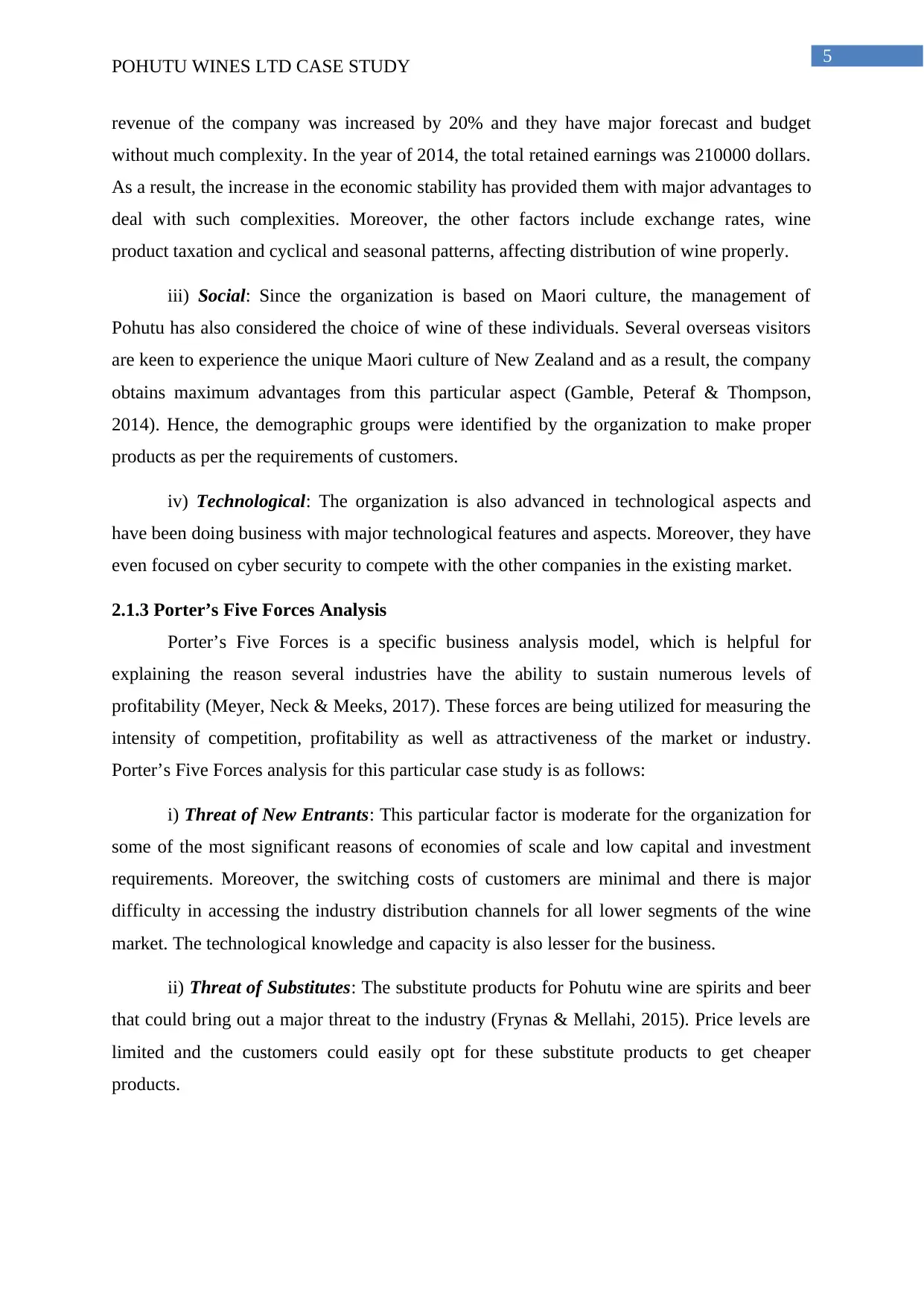
5
POHUTU WINES LTD CASE STUDY
revenue of the company was increased by 20% and they have major forecast and budget
without much complexity. In the year of 2014, the total retained earnings was 210000 dollars.
As a result, the increase in the economic stability has provided them with major advantages to
deal with such complexities. Moreover, the other factors include exchange rates, wine
product taxation and cyclical and seasonal patterns, affecting distribution of wine properly.
iii) Social: Since the organization is based on Maori culture, the management of
Pohutu has also considered the choice of wine of these individuals. Several overseas visitors
are keen to experience the unique Maori culture of New Zealand and as a result, the company
obtains maximum advantages from this particular aspect (Gamble, Peteraf & Thompson,
2014). Hence, the demographic groups were identified by the organization to make proper
products as per the requirements of customers.
iv) Technological: The organization is also advanced in technological aspects and
have been doing business with major technological features and aspects. Moreover, they have
even focused on cyber security to compete with the other companies in the existing market.
2.1.3 Porter’s Five Forces Analysis
Porter’s Five Forces is a specific business analysis model, which is helpful for
explaining the reason several industries have the ability to sustain numerous levels of
profitability (Meyer, Neck & Meeks, 2017). These forces are being utilized for measuring the
intensity of competition, profitability as well as attractiveness of the market or industry.
Porter’s Five Forces analysis for this particular case study is as follows:
i) Threat of New Entrants: This particular factor is moderate for the organization for
some of the most significant reasons of economies of scale and low capital and investment
requirements. Moreover, the switching costs of customers are minimal and there is major
difficulty in accessing the industry distribution channels for all lower segments of the wine
market. The technological knowledge and capacity is also lesser for the business.
ii) Threat of Substitutes: The substitute products for Pohutu wine are spirits and beer
that could bring out a major threat to the industry (Frynas & Mellahi, 2015). Price levels are
limited and the customers could easily opt for these substitute products to get cheaper
products.
POHUTU WINES LTD CASE STUDY
revenue of the company was increased by 20% and they have major forecast and budget
without much complexity. In the year of 2014, the total retained earnings was 210000 dollars.
As a result, the increase in the economic stability has provided them with major advantages to
deal with such complexities. Moreover, the other factors include exchange rates, wine
product taxation and cyclical and seasonal patterns, affecting distribution of wine properly.
iii) Social: Since the organization is based on Maori culture, the management of
Pohutu has also considered the choice of wine of these individuals. Several overseas visitors
are keen to experience the unique Maori culture of New Zealand and as a result, the company
obtains maximum advantages from this particular aspect (Gamble, Peteraf & Thompson,
2014). Hence, the demographic groups were identified by the organization to make proper
products as per the requirements of customers.
iv) Technological: The organization is also advanced in technological aspects and
have been doing business with major technological features and aspects. Moreover, they have
even focused on cyber security to compete with the other companies in the existing market.
2.1.3 Porter’s Five Forces Analysis
Porter’s Five Forces is a specific business analysis model, which is helpful for
explaining the reason several industries have the ability to sustain numerous levels of
profitability (Meyer, Neck & Meeks, 2017). These forces are being utilized for measuring the
intensity of competition, profitability as well as attractiveness of the market or industry.
Porter’s Five Forces analysis for this particular case study is as follows:
i) Threat of New Entrants: This particular factor is moderate for the organization for
some of the most significant reasons of economies of scale and low capital and investment
requirements. Moreover, the switching costs of customers are minimal and there is major
difficulty in accessing the industry distribution channels for all lower segments of the wine
market. The technological knowledge and capacity is also lesser for the business.
ii) Threat of Substitutes: The substitute products for Pohutu wine are spirits and beer
that could bring out a major threat to the industry (Frynas & Mellahi, 2015). Price levels are
limited and the customers could easily opt for these substitute products to get cheaper
products.
⊘ This is a preview!⊘
Do you want full access?
Subscribe today to unlock all pages.

Trusted by 1+ million students worldwide
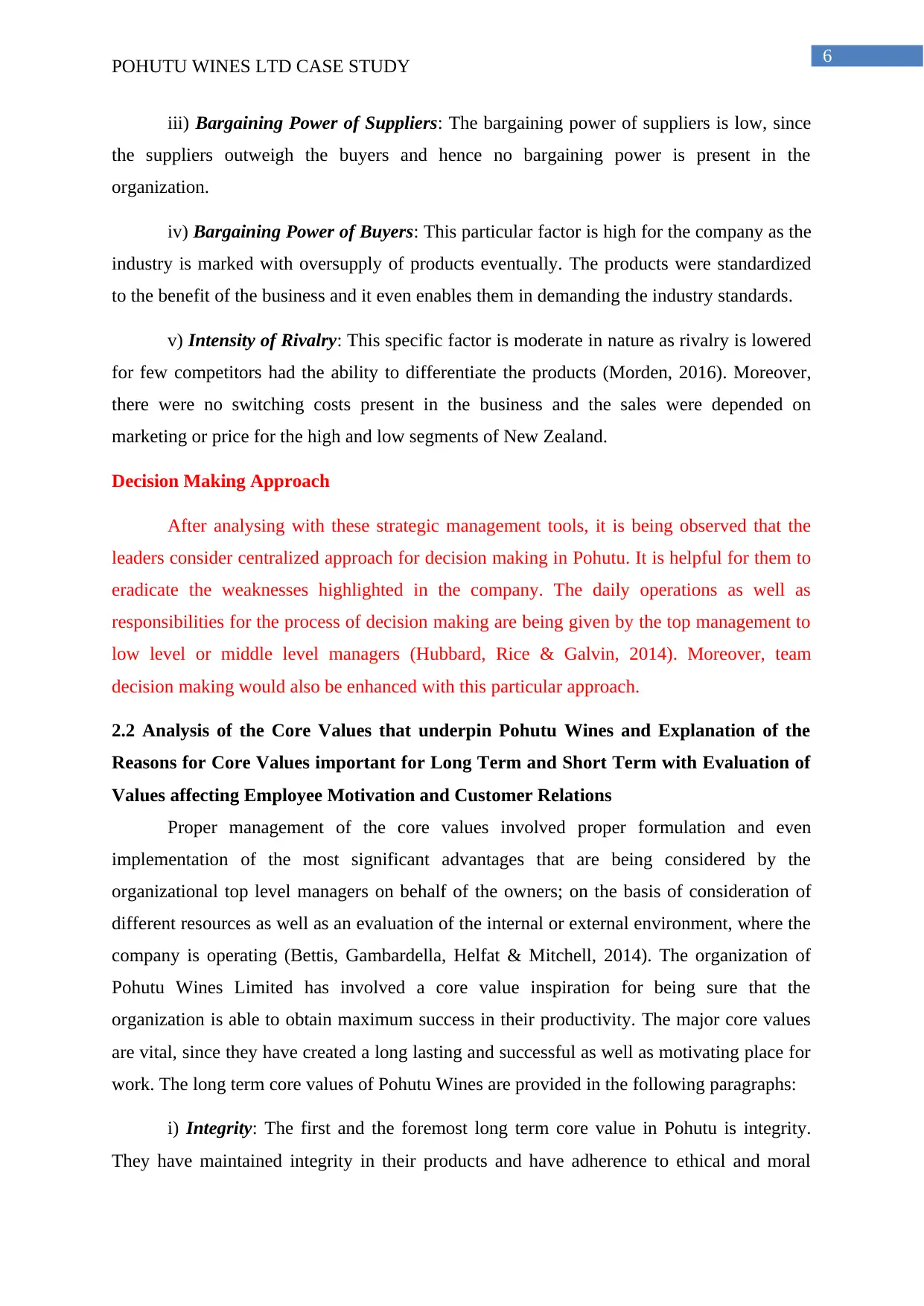
6
POHUTU WINES LTD CASE STUDY
iii) Bargaining Power of Suppliers: The bargaining power of suppliers is low, since
the suppliers outweigh the buyers and hence no bargaining power is present in the
organization.
iv) Bargaining Power of Buyers: This particular factor is high for the company as the
industry is marked with oversupply of products eventually. The products were standardized
to the benefit of the business and it even enables them in demanding the industry standards.
v) Intensity of Rivalry: This specific factor is moderate in nature as rivalry is lowered
for few competitors had the ability to differentiate the products (Morden, 2016). Moreover,
there were no switching costs present in the business and the sales were depended on
marketing or price for the high and low segments of New Zealand.
Decision Making Approach
After analysing with these strategic management tools, it is being observed that the
leaders consider centralized approach for decision making in Pohutu. It is helpful for them to
eradicate the weaknesses highlighted in the company. The daily operations as well as
responsibilities for the process of decision making are being given by the top management to
low level or middle level managers (Hubbard, Rice & Galvin, 2014). Moreover, team
decision making would also be enhanced with this particular approach.
2.2 Analysis of the Core Values that underpin Pohutu Wines and Explanation of the
Reasons for Core Values important for Long Term and Short Term with Evaluation of
Values affecting Employee Motivation and Customer Relations
Proper management of the core values involved proper formulation and even
implementation of the most significant advantages that are being considered by the
organizational top level managers on behalf of the owners; on the basis of consideration of
different resources as well as an evaluation of the internal or external environment, where the
company is operating (Bettis, Gambardella, Helfat & Mitchell, 2014). The organization of
Pohutu Wines Limited has involved a core value inspiration for being sure that the
organization is able to obtain maximum success in their productivity. The major core values
are vital, since they have created a long lasting and successful as well as motivating place for
work. The long term core values of Pohutu Wines are provided in the following paragraphs:
i) Integrity: The first and the foremost long term core value in Pohutu is integrity.
They have maintained integrity in their products and have adherence to ethical and moral
POHUTU WINES LTD CASE STUDY
iii) Bargaining Power of Suppliers: The bargaining power of suppliers is low, since
the suppliers outweigh the buyers and hence no bargaining power is present in the
organization.
iv) Bargaining Power of Buyers: This particular factor is high for the company as the
industry is marked with oversupply of products eventually. The products were standardized
to the benefit of the business and it even enables them in demanding the industry standards.
v) Intensity of Rivalry: This specific factor is moderate in nature as rivalry is lowered
for few competitors had the ability to differentiate the products (Morden, 2016). Moreover,
there were no switching costs present in the business and the sales were depended on
marketing or price for the high and low segments of New Zealand.
Decision Making Approach
After analysing with these strategic management tools, it is being observed that the
leaders consider centralized approach for decision making in Pohutu. It is helpful for them to
eradicate the weaknesses highlighted in the company. The daily operations as well as
responsibilities for the process of decision making are being given by the top management to
low level or middle level managers (Hubbard, Rice & Galvin, 2014). Moreover, team
decision making would also be enhanced with this particular approach.
2.2 Analysis of the Core Values that underpin Pohutu Wines and Explanation of the
Reasons for Core Values important for Long Term and Short Term with Evaluation of
Values affecting Employee Motivation and Customer Relations
Proper management of the core values involved proper formulation and even
implementation of the most significant advantages that are being considered by the
organizational top level managers on behalf of the owners; on the basis of consideration of
different resources as well as an evaluation of the internal or external environment, where the
company is operating (Bettis, Gambardella, Helfat & Mitchell, 2014). The organization of
Pohutu Wines Limited has involved a core value inspiration for being sure that the
organization is able to obtain maximum success in their productivity. The major core values
are vital, since they have created a long lasting and successful as well as motivating place for
work. The long term core values of Pohutu Wines are provided in the following paragraphs:
i) Integrity: The first and the foremost long term core value in Pohutu is integrity.
They have maintained integrity in their products and have adherence to ethical and moral
Paraphrase This Document
Need a fresh take? Get an instant paraphrase of this document with our AI Paraphraser
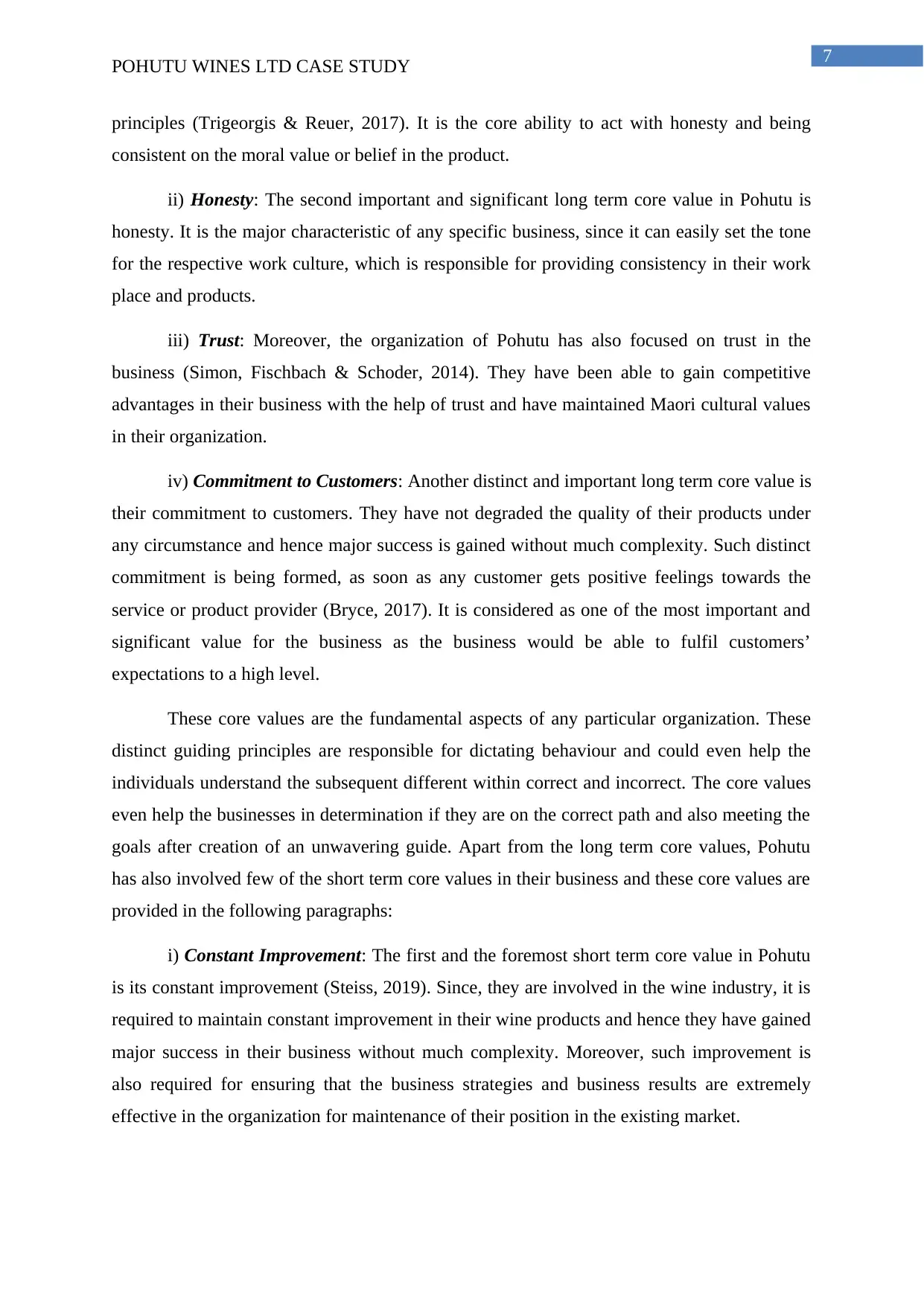
7
POHUTU WINES LTD CASE STUDY
principles (Trigeorgis & Reuer, 2017). It is the core ability to act with honesty and being
consistent on the moral value or belief in the product.
ii) Honesty: The second important and significant long term core value in Pohutu is
honesty. It is the major characteristic of any specific business, since it can easily set the tone
for the respective work culture, which is responsible for providing consistency in their work
place and products.
iii) Trust: Moreover, the organization of Pohutu has also focused on trust in the
business (Simon, Fischbach & Schoder, 2014). They have been able to gain competitive
advantages in their business with the help of trust and have maintained Maori cultural values
in their organization.
iv) Commitment to Customers: Another distinct and important long term core value is
their commitment to customers. They have not degraded the quality of their products under
any circumstance and hence major success is gained without much complexity. Such distinct
commitment is being formed, as soon as any customer gets positive feelings towards the
service or product provider (Bryce, 2017). It is considered as one of the most important and
significant value for the business as the business would be able to fulfil customers’
expectations to a high level.
These core values are the fundamental aspects of any particular organization. These
distinct guiding principles are responsible for dictating behaviour and could even help the
individuals understand the subsequent different within correct and incorrect. The core values
even help the businesses in determination if they are on the correct path and also meeting the
goals after creation of an unwavering guide. Apart from the long term core values, Pohutu
has also involved few of the short term core values in their business and these core values are
provided in the following paragraphs:
i) Constant Improvement: The first and the foremost short term core value in Pohutu
is its constant improvement (Steiss, 2019). Since, they are involved in the wine industry, it is
required to maintain constant improvement in their wine products and hence they have gained
major success in their business without much complexity. Moreover, such improvement is
also required for ensuring that the business strategies and business results are extremely
effective in the organization for maintenance of their position in the existing market.
POHUTU WINES LTD CASE STUDY
principles (Trigeorgis & Reuer, 2017). It is the core ability to act with honesty and being
consistent on the moral value or belief in the product.
ii) Honesty: The second important and significant long term core value in Pohutu is
honesty. It is the major characteristic of any specific business, since it can easily set the tone
for the respective work culture, which is responsible for providing consistency in their work
place and products.
iii) Trust: Moreover, the organization of Pohutu has also focused on trust in the
business (Simon, Fischbach & Schoder, 2014). They have been able to gain competitive
advantages in their business with the help of trust and have maintained Maori cultural values
in their organization.
iv) Commitment to Customers: Another distinct and important long term core value is
their commitment to customers. They have not degraded the quality of their products under
any circumstance and hence major success is gained without much complexity. Such distinct
commitment is being formed, as soon as any customer gets positive feelings towards the
service or product provider (Bryce, 2017). It is considered as one of the most important and
significant value for the business as the business would be able to fulfil customers’
expectations to a high level.
These core values are the fundamental aspects of any particular organization. These
distinct guiding principles are responsible for dictating behaviour and could even help the
individuals understand the subsequent different within correct and incorrect. The core values
even help the businesses in determination if they are on the correct path and also meeting the
goals after creation of an unwavering guide. Apart from the long term core values, Pohutu
has also involved few of the short term core values in their business and these core values are
provided in the following paragraphs:
i) Constant Improvement: The first and the foremost short term core value in Pohutu
is its constant improvement (Steiss, 2019). Since, they are involved in the wine industry, it is
required to maintain constant improvement in their wine products and hence they have gained
major success in their business without much complexity. Moreover, such improvement is
also required for ensuring that the business strategies and business results are extremely
effective in the organization for maintenance of their position in the existing market.
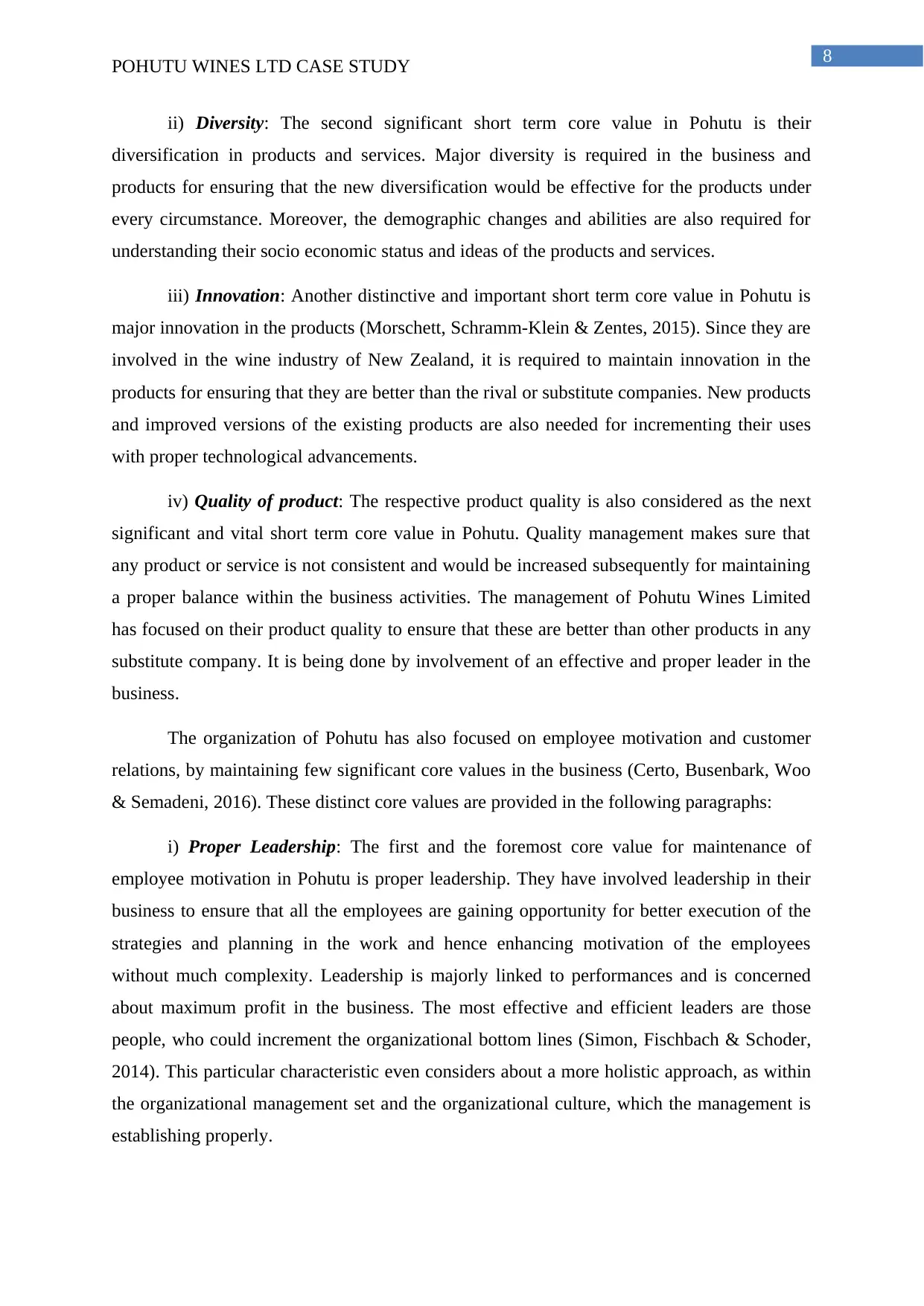
8
POHUTU WINES LTD CASE STUDY
ii) Diversity: The second significant short term core value in Pohutu is their
diversification in products and services. Major diversity is required in the business and
products for ensuring that the new diversification would be effective for the products under
every circumstance. Moreover, the demographic changes and abilities are also required for
understanding their socio economic status and ideas of the products and services.
iii) Innovation: Another distinctive and important short term core value in Pohutu is
major innovation in the products (Morschett, Schramm-Klein & Zentes, 2015). Since they are
involved in the wine industry of New Zealand, it is required to maintain innovation in the
products for ensuring that they are better than the rival or substitute companies. New products
and improved versions of the existing products are also needed for incrementing their uses
with proper technological advancements.
iv) Quality of product: The respective product quality is also considered as the next
significant and vital short term core value in Pohutu. Quality management makes sure that
any product or service is not consistent and would be increased subsequently for maintaining
a proper balance within the business activities. The management of Pohutu Wines Limited
has focused on their product quality to ensure that these are better than other products in any
substitute company. It is being done by involvement of an effective and proper leader in the
business.
The organization of Pohutu has also focused on employee motivation and customer
relations, by maintaining few significant core values in the business (Certo, Busenbark, Woo
& Semadeni, 2016). These distinct core values are provided in the following paragraphs:
i) Proper Leadership: The first and the foremost core value for maintenance of
employee motivation in Pohutu is proper leadership. They have involved leadership in their
business to ensure that all the employees are gaining opportunity for better execution of the
strategies and planning in the work and hence enhancing motivation of the employees
without much complexity. Leadership is majorly linked to performances and is concerned
about maximum profit in the business. The most effective and efficient leaders are those
people, who could increment the organizational bottom lines (Simon, Fischbach & Schoder,
2014). This particular characteristic even considers about a more holistic approach, as within
the organizational management set and the organizational culture, which the management is
establishing properly.
POHUTU WINES LTD CASE STUDY
ii) Diversity: The second significant short term core value in Pohutu is their
diversification in products and services. Major diversity is required in the business and
products for ensuring that the new diversification would be effective for the products under
every circumstance. Moreover, the demographic changes and abilities are also required for
understanding their socio economic status and ideas of the products and services.
iii) Innovation: Another distinctive and important short term core value in Pohutu is
major innovation in the products (Morschett, Schramm-Klein & Zentes, 2015). Since they are
involved in the wine industry of New Zealand, it is required to maintain innovation in the
products for ensuring that they are better than the rival or substitute companies. New products
and improved versions of the existing products are also needed for incrementing their uses
with proper technological advancements.
iv) Quality of product: The respective product quality is also considered as the next
significant and vital short term core value in Pohutu. Quality management makes sure that
any product or service is not consistent and would be increased subsequently for maintaining
a proper balance within the business activities. The management of Pohutu Wines Limited
has focused on their product quality to ensure that these are better than other products in any
substitute company. It is being done by involvement of an effective and proper leader in the
business.
The organization of Pohutu has also focused on employee motivation and customer
relations, by maintaining few significant core values in the business (Certo, Busenbark, Woo
& Semadeni, 2016). These distinct core values are provided in the following paragraphs:
i) Proper Leadership: The first and the foremost core value for maintenance of
employee motivation in Pohutu is proper leadership. They have involved leadership in their
business to ensure that all the employees are gaining opportunity for better execution of the
strategies and planning in the work and hence enhancing motivation of the employees
without much complexity. Leadership is majorly linked to performances and is concerned
about maximum profit in the business. The most effective and efficient leaders are those
people, who could increment the organizational bottom lines (Simon, Fischbach & Schoder,
2014). This particular characteristic even considers about a more holistic approach, as within
the organizational management set and the organizational culture, which the management is
establishing properly.
⊘ This is a preview!⊘
Do you want full access?
Subscribe today to unlock all pages.

Trusted by 1+ million students worldwide
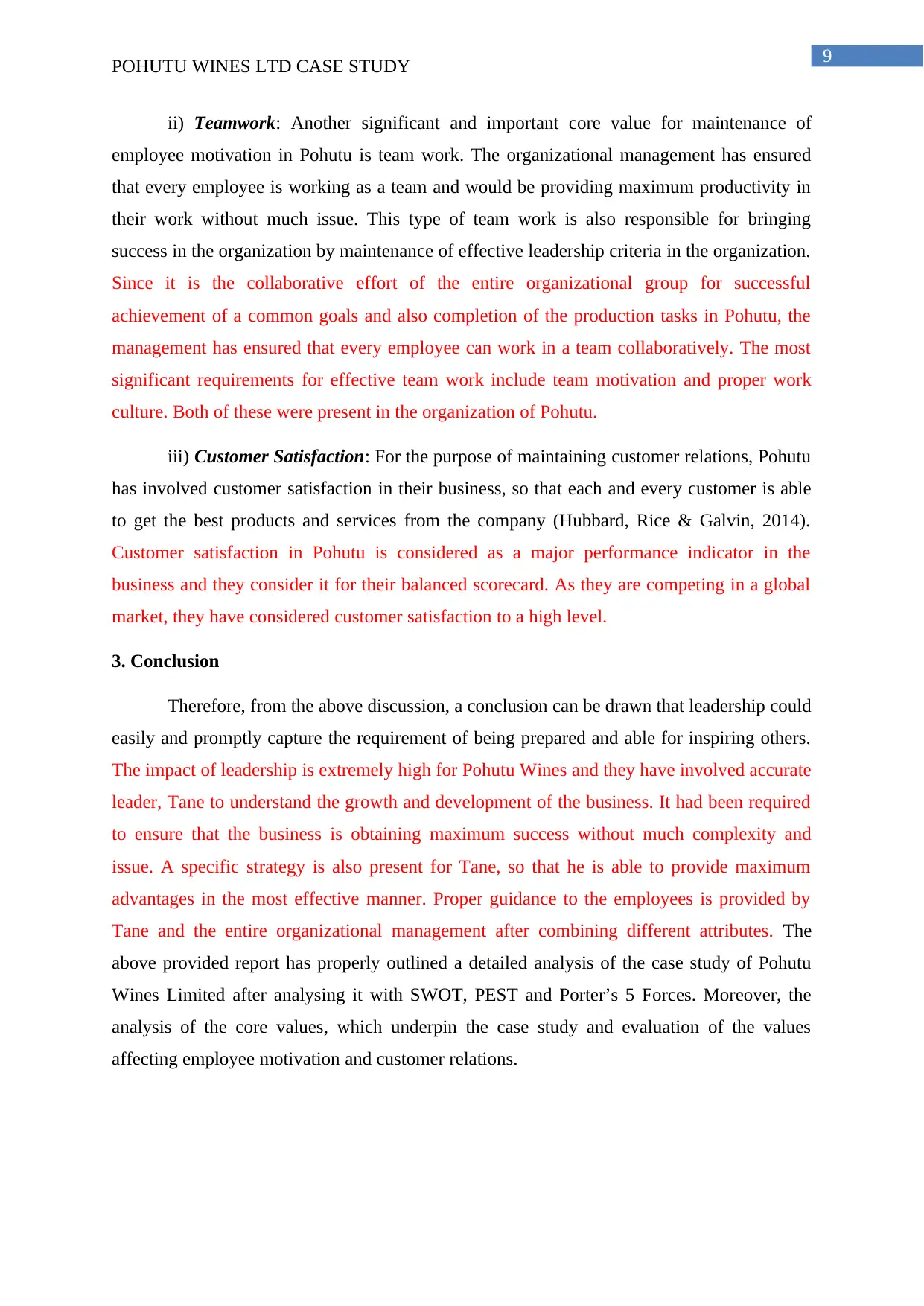
9
POHUTU WINES LTD CASE STUDY
ii) Teamwork: Another significant and important core value for maintenance of
employee motivation in Pohutu is team work. The organizational management has ensured
that every employee is working as a team and would be providing maximum productivity in
their work without much issue. This type of team work is also responsible for bringing
success in the organization by maintenance of effective leadership criteria in the organization.
Since it is the collaborative effort of the entire organizational group for successful
achievement of a common goals and also completion of the production tasks in Pohutu, the
management has ensured that every employee can work in a team collaboratively. The most
significant requirements for effective team work include team motivation and proper work
culture. Both of these were present in the organization of Pohutu.
iii) Customer Satisfaction: For the purpose of maintaining customer relations, Pohutu
has involved customer satisfaction in their business, so that each and every customer is able
to get the best products and services from the company (Hubbard, Rice & Galvin, 2014).
Customer satisfaction in Pohutu is considered as a major performance indicator in the
business and they consider it for their balanced scorecard. As they are competing in a global
market, they have considered customer satisfaction to a high level.
3. Conclusion
Therefore, from the above discussion, a conclusion can be drawn that leadership could
easily and promptly capture the requirement of being prepared and able for inspiring others.
The impact of leadership is extremely high for Pohutu Wines and they have involved accurate
leader, Tane to understand the growth and development of the business. It had been required
to ensure that the business is obtaining maximum success without much complexity and
issue. A specific strategy is also present for Tane, so that he is able to provide maximum
advantages in the most effective manner. Proper guidance to the employees is provided by
Tane and the entire organizational management after combining different attributes. The
above provided report has properly outlined a detailed analysis of the case study of Pohutu
Wines Limited after analysing it with SWOT, PEST and Porter’s 5 Forces. Moreover, the
analysis of the core values, which underpin the case study and evaluation of the values
affecting employee motivation and customer relations.
POHUTU WINES LTD CASE STUDY
ii) Teamwork: Another significant and important core value for maintenance of
employee motivation in Pohutu is team work. The organizational management has ensured
that every employee is working as a team and would be providing maximum productivity in
their work without much issue. This type of team work is also responsible for bringing
success in the organization by maintenance of effective leadership criteria in the organization.
Since it is the collaborative effort of the entire organizational group for successful
achievement of a common goals and also completion of the production tasks in Pohutu, the
management has ensured that every employee can work in a team collaboratively. The most
significant requirements for effective team work include team motivation and proper work
culture. Both of these were present in the organization of Pohutu.
iii) Customer Satisfaction: For the purpose of maintaining customer relations, Pohutu
has involved customer satisfaction in their business, so that each and every customer is able
to get the best products and services from the company (Hubbard, Rice & Galvin, 2014).
Customer satisfaction in Pohutu is considered as a major performance indicator in the
business and they consider it for their balanced scorecard. As they are competing in a global
market, they have considered customer satisfaction to a high level.
3. Conclusion
Therefore, from the above discussion, a conclusion can be drawn that leadership could
easily and promptly capture the requirement of being prepared and able for inspiring others.
The impact of leadership is extremely high for Pohutu Wines and they have involved accurate
leader, Tane to understand the growth and development of the business. It had been required
to ensure that the business is obtaining maximum success without much complexity and
issue. A specific strategy is also present for Tane, so that he is able to provide maximum
advantages in the most effective manner. Proper guidance to the employees is provided by
Tane and the entire organizational management after combining different attributes. The
above provided report has properly outlined a detailed analysis of the case study of Pohutu
Wines Limited after analysing it with SWOT, PEST and Porter’s 5 Forces. Moreover, the
analysis of the core values, which underpin the case study and evaluation of the values
affecting employee motivation and customer relations.
Paraphrase This Document
Need a fresh take? Get an instant paraphrase of this document with our AI Paraphraser
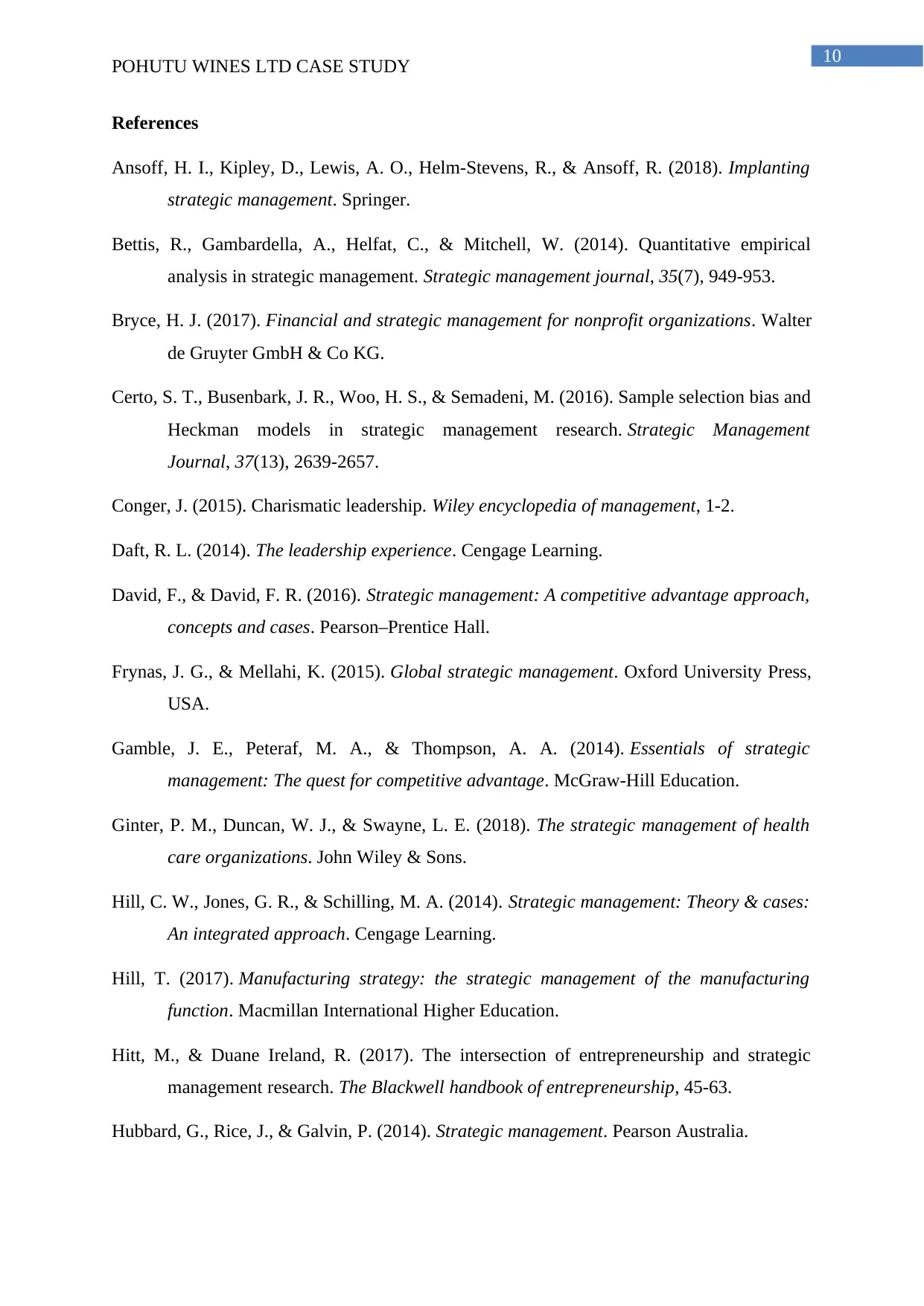
10
POHUTU WINES LTD CASE STUDY
References
Ansoff, H. I., Kipley, D., Lewis, A. O., Helm-Stevens, R., & Ansoff, R. (2018). Implanting
strategic management. Springer.
Bettis, R., Gambardella, A., Helfat, C., & Mitchell, W. (2014). Quantitative empirical
analysis in strategic management. Strategic management journal, 35(7), 949-953.
Bryce, H. J. (2017). Financial and strategic management for nonprofit organizations. Walter
de Gruyter GmbH & Co KG.
Certo, S. T., Busenbark, J. R., Woo, H. S., & Semadeni, M. (2016). Sample selection bias and
Heckman models in strategic management research. Strategic Management
Journal, 37(13), 2639-2657.
Conger, J. (2015). Charismatic leadership. Wiley encyclopedia of management, 1-2.
Daft, R. L. (2014). The leadership experience. Cengage Learning.
David, F., & David, F. R. (2016). Strategic management: A competitive advantage approach,
concepts and cases. Pearson–Prentice Hall.
Frynas, J. G., & Mellahi, K. (2015). Global strategic management. Oxford University Press,
USA.
Gamble, J. E., Peteraf, M. A., & Thompson, A. A. (2014). Essentials of strategic
management: The quest for competitive advantage. McGraw-Hill Education.
Ginter, P. M., Duncan, W. J., & Swayne, L. E. (2018). The strategic management of health
care organizations. John Wiley & Sons.
Hill, C. W., Jones, G. R., & Schilling, M. A. (2014). Strategic management: Theory & cases:
An integrated approach. Cengage Learning.
Hill, T. (2017). Manufacturing strategy: the strategic management of the manufacturing
function. Macmillan International Higher Education.
Hitt, M., & Duane Ireland, R. (2017). The intersection of entrepreneurship and strategic
management research. The Blackwell handbook of entrepreneurship, 45-63.
Hubbard, G., Rice, J., & Galvin, P. (2014). Strategic management. Pearson Australia.
POHUTU WINES LTD CASE STUDY
References
Ansoff, H. I., Kipley, D., Lewis, A. O., Helm-Stevens, R., & Ansoff, R. (2018). Implanting
strategic management. Springer.
Bettis, R., Gambardella, A., Helfat, C., & Mitchell, W. (2014). Quantitative empirical
analysis in strategic management. Strategic management journal, 35(7), 949-953.
Bryce, H. J. (2017). Financial and strategic management for nonprofit organizations. Walter
de Gruyter GmbH & Co KG.
Certo, S. T., Busenbark, J. R., Woo, H. S., & Semadeni, M. (2016). Sample selection bias and
Heckman models in strategic management research. Strategic Management
Journal, 37(13), 2639-2657.
Conger, J. (2015). Charismatic leadership. Wiley encyclopedia of management, 1-2.
Daft, R. L. (2014). The leadership experience. Cengage Learning.
David, F., & David, F. R. (2016). Strategic management: A competitive advantage approach,
concepts and cases. Pearson–Prentice Hall.
Frynas, J. G., & Mellahi, K. (2015). Global strategic management. Oxford University Press,
USA.
Gamble, J. E., Peteraf, M. A., & Thompson, A. A. (2014). Essentials of strategic
management: The quest for competitive advantage. McGraw-Hill Education.
Ginter, P. M., Duncan, W. J., & Swayne, L. E. (2018). The strategic management of health
care organizations. John Wiley & Sons.
Hill, C. W., Jones, G. R., & Schilling, M. A. (2014). Strategic management: Theory & cases:
An integrated approach. Cengage Learning.
Hill, T. (2017). Manufacturing strategy: the strategic management of the manufacturing
function. Macmillan International Higher Education.
Hitt, M., & Duane Ireland, R. (2017). The intersection of entrepreneurship and strategic
management research. The Blackwell handbook of entrepreneurship, 45-63.
Hubbard, G., Rice, J., & Galvin, P. (2014). Strategic management. Pearson Australia.
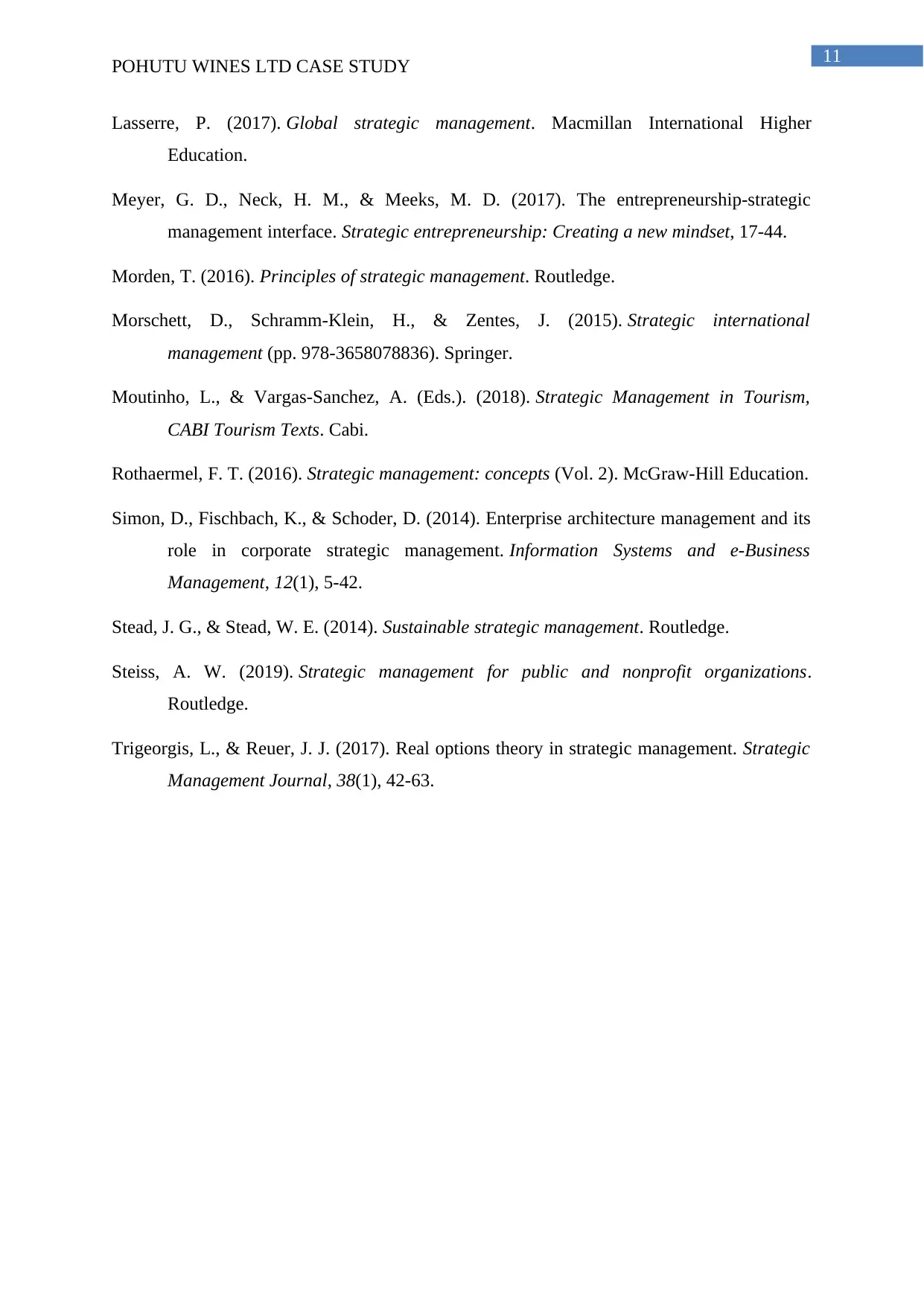
11
POHUTU WINES LTD CASE STUDY
Lasserre, P. (2017). Global strategic management. Macmillan International Higher
Education.
Meyer, G. D., Neck, H. M., & Meeks, M. D. (2017). The entrepreneurship‐strategic
management interface. Strategic entrepreneurship: Creating a new mindset, 17-44.
Morden, T. (2016). Principles of strategic management. Routledge.
Morschett, D., Schramm-Klein, H., & Zentes, J. (2015). Strategic international
management (pp. 978-3658078836). Springer.
Moutinho, L., & Vargas-Sanchez, A. (Eds.). (2018). Strategic Management in Tourism,
CABI Tourism Texts. Cabi.
Rothaermel, F. T. (2016). Strategic management: concepts (Vol. 2). McGraw-Hill Education.
Simon, D., Fischbach, K., & Schoder, D. (2014). Enterprise architecture management and its
role in corporate strategic management. Information Systems and e-Business
Management, 12(1), 5-42.
Stead, J. G., & Stead, W. E. (2014). Sustainable strategic management. Routledge.
Steiss, A. W. (2019). Strategic management for public and nonprofit organizations.
Routledge.
Trigeorgis, L., & Reuer, J. J. (2017). Real options theory in strategic management. Strategic
Management Journal, 38(1), 42-63.
POHUTU WINES LTD CASE STUDY
Lasserre, P. (2017). Global strategic management. Macmillan International Higher
Education.
Meyer, G. D., Neck, H. M., & Meeks, M. D. (2017). The entrepreneurship‐strategic
management interface. Strategic entrepreneurship: Creating a new mindset, 17-44.
Morden, T. (2016). Principles of strategic management. Routledge.
Morschett, D., Schramm-Klein, H., & Zentes, J. (2015). Strategic international
management (pp. 978-3658078836). Springer.
Moutinho, L., & Vargas-Sanchez, A. (Eds.). (2018). Strategic Management in Tourism,
CABI Tourism Texts. Cabi.
Rothaermel, F. T. (2016). Strategic management: concepts (Vol. 2). McGraw-Hill Education.
Simon, D., Fischbach, K., & Schoder, D. (2014). Enterprise architecture management and its
role in corporate strategic management. Information Systems and e-Business
Management, 12(1), 5-42.
Stead, J. G., & Stead, W. E. (2014). Sustainable strategic management. Routledge.
Steiss, A. W. (2019). Strategic management for public and nonprofit organizations.
Routledge.
Trigeorgis, L., & Reuer, J. J. (2017). Real options theory in strategic management. Strategic
Management Journal, 38(1), 42-63.
⊘ This is a preview!⊘
Do you want full access?
Subscribe today to unlock all pages.

Trusted by 1+ million students worldwide
1 out of 12
Related Documents
Your All-in-One AI-Powered Toolkit for Academic Success.
+13062052269
info@desklib.com
Available 24*7 on WhatsApp / Email
![[object Object]](/_next/static/media/star-bottom.7253800d.svg)
Unlock your academic potential
Copyright © 2020–2025 A2Z Services. All Rights Reserved. Developed and managed by ZUCOL.





